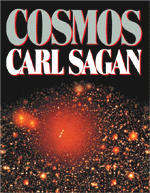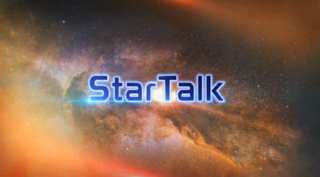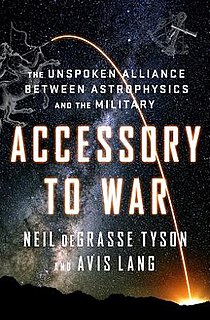
Neil deGrasse Tyson is an American astrophysicist, planetary scientist, author, and science communicator.

Cosmos is a 1980 popular science book by astronomer and Pulitzer Prize-winning author Carl Sagan. Its 13 illustrated chapters, corresponding to the 13 episodes of the Cosmos TV series, which the book was co-developed with and intended to complement, explore the mutual development of science and civilization. One of Sagan's main purposes for the book and television series was to explain complex scientific ideas to anyone interested in learning. Sagan also believed the television was one of the greatest teaching tools ever invented, so he wished to capitalize on his chance to educate the world. Spurred in part by the popularity of the TV series, Cosmos spent 50 weeks on the Publishers Weekly best-sellers list and 70 weeks on the New York Times Best Seller list to become the best-selling science book ever published at the time. In 1981, it received the Hugo Award for Best Non-Fiction Book. The book's unprecedented success ushered in a dramatic increase in visibility for science-themed literature. The success of the book also jumpstarted Sagan's literary career. The sequel to Cosmos is Pale Blue Dot: A Vision of the Human Future in Space (1994).

Manhattanhenge, also called the Manhattan Solstice, is an event during which the setting sun or the rising sun is aligned with the east–west streets of the main street grid of Manhattan, New York City. The sunsets and sunrises each align twice a year, on dates evenly spaced around the summer solstice and winter solstice. The sunset alignments occur around May 28 and July 13. The sunrise alignments occur around December 5 and January 8. Excellent places for viewing Manhattanhenge are 14th, 23rd, 34th, 42nd, and 57th Streets.

The Rose Center for Earth and Space is a part of the American Museum of Natural History in New York City. The Center's complete name is The Frederick Phineas and Sandra Priest Rose Center for Earth and Space. The main entrance is located on the northern side of the museum on 81st Street near Central Park West in Manhattan's Upper West Side. Completed in 2000, it includes the new Hayden Planetarium, the original of which was opened in 1935 and closed in 1997. Neil deGrasse Tyson is its first and, to date, only director.
13123 Tyson, provisional designation 1994 KA, is a stony Phocaea asteroid and an asynchronous binary system from the inner regions of the asteroid belt, approximately 10 kilometers in diameter. It was discovered on May 16, 1994, by American astronomer Carolyn Shoemaker and Canadian astronomer David Levy at the Palomar Observatory in California, United States. The asteroid was named for Neil deGrasse Tyson, American astrophysicist and popular science communicator.

David H. Grinspoon is an American astrobiologist. He is Senior Scientist at the Planetary Science Institute and was the former inaugural Baruch S. Blumberg NASA/Library of Congress Chair in Astrobiology for 2012-2013.

The Pluto Files: The Rise and Fall of America's Favorite Planet is a book written by the astrophysicist and Hayden Planetarium director Neil deGrasse Tyson. The book is about Pluto, which was demoted to the status of dwarf planet in August 2006 by the International Astronomical Union, thereby depriving it of its planet-hood. The book also focuses on the fact that many Americans rallied their support for this icy dwarf on the edge of the Solar System because it was discovered by an American.

The Symphony of Science is a music project created by Washington-based electronic musician John D. Boswell. The project seeks to "spread scientific knowledge and philosophy through musical remixes." Boswell uses pitch-corrected audio and video samples from television programs featuring popular educators and scientists. The audio and video clips are mixed into digital mashups and scored with Boswell's original compositions. Two of Boswell's music videos, "A Glorious Dawn" and "We are All Connected", feature appearances from Carl Sagan, Richard Feynman, Neil deGrasse Tyson, Bill Nye, and Stephen Hawking. The audio and video is sampled from popular science television shows including Cosmos, The Universe, The Eyes of Nye, The Elegant Universe, and Stephen Hawking's Universe.

Cosmos: A Spacetime Odyssey is a 2014 American science documentary television series. The show is a follow-up to the 1980 television series Cosmos: A Personal Voyage, which was presented by Carl Sagan on the Public Broadcasting Service and is considered a milestone for scientific documentaries. This series was developed to bring back the foundation of science to network television at the height of other scientific-based television series and films. The show is presented by astrophysicist Neil deGrasse Tyson, who, as a young high school student, was inspired by Sagan. Among the executive producers are Seth MacFarlane, whose financial investment was instrumental in bringing the show to broadcast television, and Ann Druyan, a co-author and co-creator of the original television series and Sagan's wife. The show is produced by Brannon Braga, and Alan Silvestri composed the backing score.

Minute Physics is an educational YouTube channel created by Henry Reich in 2011. The channel's videos use whiteboard animation to explain physics-related topics in approximately one minute. As of June 2020, the channel has more than 5 million subscribers.
The Space Show is a biweekly Internet radio talk show, presented by David Livingston, about space commerce and exploration that is also available archived online as a podcast. According to Livingston, the show started in 2001 as Business without Boundaries on a small Arizona radio station, which added Internet audio streaming later. When the show moved to Seattle in 2002, it was renamed The Space Show and aired on, and streamed from, KKNW.

Penny4NASA is a campaign run by the Space Advocates nonprofit, a nonpartisan organization seeking to promote the expansion of funding for the economic, scientific and cultural value of the United States' national space program by advocating an increase in the budget for the National Aeronautics and Space Administration to at least one percent of the United States Federal Budget. Penny4NASA also attempts to promote public awareness of the NASA mission and budget, and has produced a series of outreach videos, as well as performing educational outreach via social media.
"Standing Up in the Milky Way" is the first aired episode of the American documentary television series Cosmos: A Spacetime Odyssey. It premiered on March 9, 2014, simultaneously on various Fox television networks, including National Geographic Channel, FX, Fox Life, and others. The episode is presented by the series host astrophysicist Neil deGrasse Tyson, directed by Brannon Braga, produced by Livia Hanich and Steven Holtzman, and written by Ann Druyan and Steven Soter.

StarTalk is a podcast on space, science, and popular culture hosted by astrophysicist Neil deGrasse Tyson, with various comic and celebrity co-hosts and frequent guests from the worlds of science and entertainment. Past co-hosts have included Colin Jost, Lynne Koplitz, Leighann Lord, Eugene Mirman, Chuck Nice, John Oliver, and Kristen Schaal. Guests have included astronaut Buzz Aldrin, actor Morgan Freeman, George Takei, comedian Joan Rivers, Arianna Huffington, Youtuber Sam Denby, Richard Dawkins and writer Mary Roach. StarTalk has a segment called Cosmic Queries, in which listeners send in questions about the universe to be answered on the show.

StarTalk is an American talk show hosted by Neil deGrasse Tyson that airs weekly on National Geographic. StarTalk is a spin-off of the podcast of the same name, in which Tyson discusses scientific topics through one-on-one interviews and panel discussions. Space.com called it the "first-ever science-themed late-night talk show." The series premiered on April 20, 2015.

"Flatline" is a song by American rapper B.o.B, initially released on SoundCloud in January 2016. It is a diss track aimed at physicist Neil DeGrasse Tyson, whom he had gotten into an argument with on Twitter, over B.o.B's stated belief that the earth is flat. In addition to dissing Tyson and expressing belief in a flat earth, the song's lyrics also include other conspiracy theories, including Holocaust denial, "mirror lizards", and the belief that Freemasons are indoctrinating young people. The lyrics to the song refer to science as a cult.
Space Odyssey: The Video Game is an upcoming sandbox video game with 4X elements being developed by Space Media Ventures for Microsoft Windows, macOS, Linux, iOS, and Android systems, including virtual reality devices, anticipated for release in 2019. The game is being co-developed by astrophysicist Neil deGrasse Tyson, and will have some educational aspects as the player designs and grows parts of a virtual galaxy.

Matthew John O'Dowd is an Australian astrophysicist. He is an associate professor in the Physics and Astronomy Department at the Lehman College of the City University of New York and writer and host of PBS Space Time on YouTube. He is a frequent guest on Science Goes to the Movies on CUNY TV and on StarTalk radio with Neil deGrasse Tyson.

Cosmos: Possible Worlds is a 2020 American science documentary television series that premiered on March 9, 2020, on National Geographic. The series is a follow-up to the 2014 television series Cosmos: A Spacetime Odyssey, which followed the original Cosmos: A Personal Voyage series presented by Carl Sagan on PBS in 1980. The series is presented by astrophysicist Neil deGrasse Tyson, written, directed, and executive-produced by Ann Druyan and Brannon Braga, with other executive producers being Seth MacFarlane and Jason Clark.

Accessory to War: The Unspoken Alliance Between Astrophysics and the Military is the fifteenth book by American astrophysicist and science communicator Neil deGrasse Tyson which he co-wrote with researcher and writer Avis Lang. It was released on September 11, 2018 by W. W. Norton & Company. The book chronicles war and the use of space as a weapon, including Christopher Columbus use of his knowledge of a lunar eclipse and the use of satellite intelligence by the United States during the Gulf War.

















